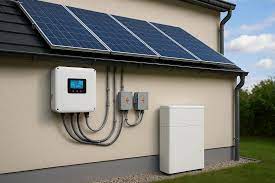Imagine a crisp autumn evening in a small mountain town, where the sun dips below the horizon, casting long shadows over a cozy cabin. The wind howls, and a sudden storm knocks out the power grid, plunging the neighborhood into darkness. But inside one home, the lights flicker on seamlessly, the refrigerator hums quietly, and the family gathers around the dinner table without missing a beat. This isn’t magic—it’s the quiet revolution of solar batteries at work, storing the day’s abundant sunlight to power through the night. In a world increasingly reliant on renewable energy, solar batteries are emerging as the unsung heroes, bridging the gap between sunny days and energy demands.
What Are Solar Batteries?
Solar batteries are specialized energy storage systems designed to capture and hold electricity generated from solar panels. Unlike traditional batteries, they are optimized for renewable energy applications, ensuring that excess power produced during peak sunlight hours isn’t wasted but saved for later use.
How Solar Batteries Work
At their core, these storage units convert direct current (DC) electricity from solar panels into alternating current (AC) for household appliances, often through an inverter. During the day, solar panels harvest sunlight, and any surplus energy charges the battery. When the sun sets or during cloudy weather, the stored power is discharged to keep your home running. This process relies on advanced chemistries like lithium-ion or lead-acid, which determine efficiency, lifespan, and cost.
Types of Solar Batteries Available
There are several varieties to choose from, each suited to different needs. Lithium-ion options, popular for their high energy density and long cycle life, dominate the market. Flow batteries, using liquid electrolytes, offer scalability for larger setups. Saltwater batteries provide an eco-friendly alternative, free from heavy metals. Selecting the right type depends on factors like budget, space, and energy requirements.
Benefits of Installing Solar Batteries
Adopting this technology brings numerous advantages, from financial savings to environmental impact. By storing solar energy, homeowners reduce reliance on the grid, potentially slashing electricity bills by 50-70% in sunny regions. During outages, they provide backup power, enhancing resilience against blackouts caused by extreme weather.
Environmental Advantages
One of the standout perks is the reduction in carbon footprint. Traditional grid power often comes from fossil fuels, but pairing panels with storage shifts toward clean, renewable sources. This not only combats climate change but also promotes energy independence, lessening the strain on overburdened utilities.
Economic Incentives and Savings
Government rebates, such as the U.S. Investment Tax Credit, make installation more affordable, covering up to 30% of costs. Over time, the return on investment can be substantial, with payback periods as short as 5-10 years. Businesses, too, benefit from peak shaving—using stored energy during high-demand hours to avoid premium rates.
Choosing and Installing Solar Batteries
Selecting the ideal system involves assessing your energy consumption patterns. Start by calculating daily usage via utility bills or smart meters. Capacity, measured in kilowatt-hours (kWh), should match your needs; a typical household might require 10-20 kWh for basic backup.
Installation Process and Considerations
Professional installation is recommended to ensure safety and efficiency. It typically involves mounting the unit in a cool, ventilated space, connecting it to your solar array and inverter, and integrating smart monitoring software. Permits and inspections may be required, varying by location. Maintenance is minimal, focusing on regular checks for optimal performance.
Common Challenges and Solutions
While upfront costs can be a hurdle, financing options like loans or leases mitigate this. Depth of discharge (DoD) ratings indicate how much capacity you can safely use without degrading the battery—aim for 80-90% for longevity. Addressing these upfront leads to a smoother experience.
Future Trends in Solar Battery Technology
The field is evolving rapidly, with innovations like solid-state batteries promising higher safety and energy density. Integration with smart homes via AI allows for predictive energy management, optimizing usage based on weather forecasts. As prices drop—expected to fall 50% by 2030—adoption will surge, making renewable storage accessible to more people.
Global Adoption and Case Studies
Countries like Australia and Germany lead in deployment, with millions of homes equipped. In the U.S., California’s mandate for new homes to include solar plus storage sets a precedent. Real-world examples, such as Tesla’s Powerwall installations during hurricanes, demonstrate reliability in crises.
Conclusion
Embracing solar batteries represents a pivotal step toward a sustainable, self-reliant energy future. As technology advances and costs decline, these systems empower individuals and communities to harness the sun’s power efficiently. Whether for cost savings, environmental stewardship, or peace of mind during outages, investing in solar batteries today paves the way for a brighter tomorrow.





